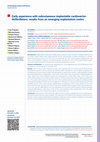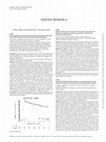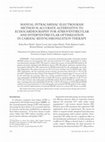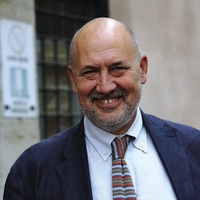Papers by Richard Matasic

Europace, Jun 1, 2020
The third-generation cryoballoon has been designed with a 40% shortened tip length compared with ... more The third-generation cryoballoon has been designed with a 40% shortened tip length compared with the former second-generation CB device. Ideally, a shorter tip could result with an improved visualization of real-time (RT) recordings in the pulmonary vein (PV) due to a more proximal positioning of the inner lumen mapping catheter. Beside the high incidence of RT recordings, for the first time, we observed dual fascicle electrograms with different isolation time for each fascicle, when using the new device. We sought to analyze the rate of visualization of RT recordings and dual fascicle electrograms in our first series of patients with the third generation cryoballoon device. All consecutive patients having undergone CB ablation using the third generation technology were analyzed. Procedures were performed under conscious sedation. A single transeptal puncture was preformed guided by intracardial ultrasound and a 28 mm cryoballoon was used. A single 180 seconds freeze strategy was employed. A total of 80 consecutive patients (77.5% male, 60.3 ± 10.8 years) were evaluated. Real-time recordings were detected in 275 of 320 PVs (85.9%). Specifically, RT recordings could be visualized in 68 left superior PVs (85%), 69 left inferior PVs (86.2%), 73 right superior PVs (91.2%), and 65 right inferior PVs (81.2%). Furthermore, in 14 of 320 PVs (4.3%) two different fascicles electrograms were detected. A distinctive isolation time for each fascicle could be observed both in sinus rhythm and in atrial fibrillation (Picture). Most commonly, dual fascicles were observed in left superior PV (7.5%) and right inferior PV (6.3%). In the rest of the veins this phenomenon was not so frequent. In 2.5% of right superior PV and in only 1.2% of left inferior PV dual fascicles could be observed. The rate of visualization of RT recordings is significantly high during third generation CB ablation. Real-time recordings can be visualized in 85.9% of veins with this novel cryoballoon. Furthermore, for the first time, isolation of two different fascicles during a single cryoballoon lesion could be observed. Other that more proximal mapping catheter position, there is second possible explanation for the visualization of dual fascicles with this novel balloon. Shorter tip could result with poorer cryoballoon stability and weaker contact with the atrium wall, hence non-uniform freezing and isolation of different fascicles in different times. Abstract Figure.

Europace, Jun 1, 2020
As catheter ablation became the standard therapy for atrial fibrillation (AF), the number of AF p... more As catheter ablation became the standard therapy for atrial fibrillation (AF), the number of AF procedures has risen exponentially. Therefore, workflow optimization is crucial in order to meet the rising demands for EP interventions. Recently, instead of standard groin compression we have started using the "Z stitch" for introducers’ removal. This novel method does not necessitate protamine administration and often lengthy manual compression. We aim to demonstrate utilization of "Z stitch" for groin access closure in cryoballoon (CB) ablation and its impact on EP lab workflow. We have analyzed all patients having undergone CB ablation utilizing the "Z stitch" (Z group) and the last 50 consecutive CB patients who received standard groin compression (non-Z group). Procedures were performed under conscious sedation. Both femoral veins were punctured and a single introducer was placed in each vein. A single transeptal puncture was preformed guided by intracardial ultrasound and a 28 mm cryoballoon was used. A single 180 seconds freeze strategy was employed. In the past, protamine was slowly administered after ablation and at least 15 minute manual groin compression was applied until no visual bleeding could be detected. Elastic bandage was placed around both groins. Later on, the "Z stitch" was used around both introducers without the need for protamine administration, manual compression and bandage placement (Picture). The stitches were removed next morning. A total of 100 consecutive patients (79% male, 61.2 ± 10.6 years old) were evaluated, 50 in both groups. There was no difference in the mean procedure duration ("skin to skin") between two groups. However, a total lab time was significantly longer in non-Z group. There was no differences in complication rates, which consisted solely of phrenic nerve palsy and groin complications. There was no AV fistula or pseudoaneurysms detected in our cohort (Table). Utilization of Z stitches for introduces’ removal seems safe and effective way to achieve hemostasis after cryoballoon ablation. It abolishes the need for protamine administration which can cause serious advert events. Manual compression is no longer required. Consequently, EP lab workflow is improved, since the total lab time utilization per patient is significantly shortened. Results non-Z group Z group p Procedure duration (min) 69.4 ± 20.4 73.4 ± 24.8 0.380 Lab time (min) 129.9 ± 35.3 109.1 ± 30.6 0.002 Complications (N) 5 (2 hematoma) 4 (2 hematoma) NS Abstract Figure. Z stich

Background: Although cardiac resynchronization therapy (CRT) is well established as adjunctive he... more Background: Although cardiac resynchronization therapy (CRT) is well established as adjunctive heart failure treatment, a 30% rate of non-responders poses a challenge to improve the detection of potential responders prior to device implantation. A mechanism based approach to patient selection has been previously proposed, part of which is the septal flash as an echocardiographic sign of intraventricular dyssynchrony, predictive of CRT response. Methods: In this pilot study, data from 5 consecutive patents (2F/3M, 63± ; 10 years) referred for CRT implantation by mini-thoracotomy were analyzed. Intraoperative transthoracic or transoesophageal echocardiography as well as Doppler myocardial imaging data were acquired pre- and post-CRT device implantation. The septal flash was defined as an early ventricular septal motion within the isovolumic contraction period, imaged using gray-scale or Tissue Doppler colour M-mode. Reverse remodelling was defined as a reduction of end-systolic volume (LVESV) ≥ 10%. The right atrial and ventricular leads were placed transvenously, while the LV screw-in lead was positioned epicardially on the lateral wall, avoiding areas of magnetic resonance late-enhancement. Results: The septal flash was detected preoperatively in all patients and resolved immediately after onset of biventricular pacing. A significant post-implantation reduction of LVESV (248± ; 99 ml vs.190± ; 100 ml, P=0.01) and increase in EF (19± ; 5% vs. 27± ; 4%, P=0.01) were measured in all patients. Likewise, a significant increase of post-implantation dP/dt measured noninvasively from the mitral regurgitation trace was noted in all patients (321.3± ; 32.2 mmHg/s vs. 655.9± ; 29.8 mmHg/s, P=0.001). Conclusion: Preoperative presence of the septal flash is a valid predictor of LV reverse remodelling and increase in contractility which occur immediately after CRT-device implantation.
Acta Clinica Croatica, 2018
Four thousand cardiac implantable electronic devices (CIED) are implanted yearly in Croatia with ... more Four thousand cardiac implantable electronic devices (CIED) are implanted yearly in Croatia with constant increase. General anesthesia and surgery carry some specifi c risk for the patients with implanted CIEDs. Since most of the surgical procedures are performed in institutions without reprogramming devices available, or in the periods when they are unavailable, these guidelines aim to standardize the protocol for perioperative management of these patients. With this protocol, most of the procedures can be performed easily and, more importantly, safely in the majority of surgical patients.

Cardiologia Croatica, Nov 1, 2022
Implantable cardioverter-defibrillators (ICD) are a gold-standard therapy for prevention of sudde... more Implantable cardioverter-defibrillators (ICD) are a gold-standard therapy for prevention of sudden cardiac death (SCD). 1 Subcutaneous ICDs (S-ICD) provide a valuable alternative to conventional transvenous devices (TV-ICD) and can eliminate the risk of lead-related complications and lower risk of systemic infection in selected patients. Introduction of this technology involves higher economic burden and period of learning in emerging implantation centers. Patients and Methods: We analyzed data regarding all S-ICDs implanted since the introduction of the procedure in our institution in December 2021. Results: There were in total 7 patients (4 male and 3 female) with the median age 49 (28-64 years). All patients received S-ICD for primary prevention of SCD. Indications were as follows: ischemic cardiomyopathy (3 cases), hypertrophic cardiomyopathy (2 cases), non-ischemic cardiomyopathy (1 case) and catecholaminergic polymorphic ventricular tachycardia with concomitant cardiomyopathy (1 case). There were several different reasons for implantation of S-ICD rather than TV-ICD. Three patients suffered from severe kidney failure and two of them already had chronic dialysis catheters in situ. One patient had a previous infection of TV-ICD. Another patient with ischemic cardiomyopathy and repaired tetralogy of Fallot was not suitable for TV-ICD due to occlusion of left subclavian vein and probable need for future percutaneous implantation of pulmonary valve. In one patient S-ICD was a preferred option due to young age. First 6 cases were implanted with support of an experienced proctor. In one case the defibrillation test was repeatedly unsuccessful, and the patient required multiple external defibrillations. Reposition of the device was scheduled with optimal final result. No other complications were observed periprocedural or during follow-up. Conclusion: Subcutaneous ICDs have been safely and successfully implemented in our cardiology department without special surgical support. This experience will help to better address the need for prevention of SCD in special populations of patients. Although the total number of patients is still rather low, this could be improved by overcoming reimbursement issues.

Europace, Mar 1, 2018
Background: Complete pulmonary vein isolation (PVI) is the best documented target for catheter ab... more Background: Complete pulmonary vein isolation (PVI) is the best documented target for catheter ablation of paroxysmal AF. Better rhythm outcome and lower procedurerelated complications can be expected in patients in the absence of significant structural heart disease (SHD). Purpose: to assess and compare outcome for an index CryoBalloon (CB) PVI in paroxysmal AF population with and without SHD. Methods: From April 2012 to May 2017, 1337 paroxysmal AF patients (73% male, 59 6 11 years; mean left atrial diameter 4166 mm) underwent CB-PVI. Data were collected prospectively in the framework of the One Shot TO Pulmonary vein isolation (1STOP) ClinicalServiceV R project, involving 36 Italian Cardiologic Centers. All patients were divided into two groups according to the presence SHD. According to current ESC guidelines, SHD was defined as Left Ventricular (LV) systolic or diastolic dysfunction, longstanding hypertension with LV hypertrophy, and/or other structural heart disease. Data on procedural outcomes and long term freedom of AF recurrence were evaluated. Results: SHD was present in 244/1337 (18%) cases. Patients with SHD were older than those without SHD (63 6 9 vs 58611; p<0.01); they were more frequently male (79% vs 69%; p¼0.04), had lower functional capacity (NYHA class >1 30% vs 12%; p<0.001) and had higher cardioembolic risk (CHAã DSã-Vasc score 2: 62%% vs 38%; p<0.001). Moreover, the presence of SHD was associated to lower left ventricular ejection fraction (60 6 7 vs. 57 6 7; p<0.001) and higher left atrial diameter(40 6 5 vs. 446 6 mm; p<0.001) and area(21 6 5 vs. 236 5; p<0.001 cmq). The 2 groups showed comparable procedure, fluoroscopic times and acute success rate (respectively, on overall population: 114.6 6 46.5 minutes, 28.8 6 15.1 minutes and 98.5%). The rate of acute procedural complications was 5.1% (2,4% were Transient Diaphragmatic Paralysis) with no significant differences between the 2 groups. The 12month freedom of AF recurrence probability after a single CB-PVI was 78% and 77% in patients with and without SHD, respectively, (p ¼0.62) as shown in fig 1. Conclusions: In our multicenter experience, the 18% of patients treated with index Cryoballoon-PVI suffered from SHD. CB-PVI was safe and effective in paroxysmal AF patients with and without SHD.

Biochemical and Biophysical Research Communications, Sep 1, 2000
We compared the transcript profiles of human myeloid immature dendritic (IDC) cells and mature de... more We compared the transcript profiles of human myeloid immature dendritic (IDC) cells and mature dendritic cells (MDC) by hybridization of cell-derived cDNA to DNA probes immobilized on microarrays. The microarrays contained probes for 4110 known genes. We report maturation-dependent changes in transcription of clusters of differentiation, cytokines, cytokine receptors, chemokines, chemokine receptors, neuropeptides, adhesion molecules, and other genes. We identified 1124 transcripts expressed in IDC and 1556 transcripts expressed in MDC. Maturation increased the levels of 291 transcripts twofold or more and reduced the levels of 78 transcripts to one-half or less than in IDC. We identified a concerted maturation-stage-dependent transcription of the variable chains of the members of the ␥-chain-cytokine receptor family IL-4R, IL-7R, and IL-15R. Also, we found the reversal of the ratio of transcripts for galectin-3 and galectin-9 upon maturation. We identified maturation-dependent changes in the levels of transcripts for numerous genes encoding proteins previously undetected in dendritic cells such as indoleamine 2,3-deoxygenase, Epstein-Barr virus induced protein 3 and kinesin-2. Moreover, MDC transcribed and translated insulin like growth factor-1 receptor, transforming growth factor ␣, and neuropeptide Y.
European Heart Journal, Oct 1, 2022
Cardiologia Croatica, Apr 1, 2019
Cardiologia Croatica, Apr 1, 2021
European Journal of Echocardiography, Dec 20, 2013
Cardiologia Croatica, Nov 1, 2016

Europace, May 1, 2021
Funding Acknowledgements: Type of funding sources: None. Background: His bundle pacing (HBP) phys... more Funding Acknowledgements: Type of funding sources: None. Background: His bundle pacing (HBP) physiologically activates the ventricles by a direct stimulation of the His-Purkinje cardiac conduction system. It was first described in the 1970s, and the initial feasibility studies were reported in the early 2000s. Later on, technological advances led to its widespread adoption and growing evidence base. Purpose: This retrospective study aimed to assess implant success rate, feasibility and safety of the His-bundle lead implantation program in our centre. Methods: All patients who underwent His-bundle lead implantation in our centre from the start of the HBP program in November 2018 until November 2020 were analyzed. Data were collected from existing hospital electronic medical records. Results: A total of 125 patients (64.8 % male, 65.1 ± 13.9 years) were included in the study. Nearly half of patients (47.2 %) had chronic heart failure and 39.2 % had atrial fibrillation. Indications for pacing included antibradycardia pacing (68.8 %) and cardiac resynchronization therapy (31.2 %). His-bundle lead was successfully implanted in 114 patients (91.2 % acute success), while the rest of the procedures were converted into right ventricle lead placement. 32.8 % of all patients had native narrow QRS complexes. Among patients who received HBP for cardiac resynchronization therapy, QRS duration was reduced from 177.5 ± 26.4 at baseline to 145.8 ± 23.9 after HBP (p < 0.001). However, QRS duration slightly prolonged in the antibradycardia group from 118.8 ± 31.9 at baseline to 130.4 ± 25.3 after HBP (p = 0.011). Seven (8.6 %) patients in the antibradycardia group had late lead disfunction/dislodgement and therefore underwent reoperation with the conventional right ventricle lead placement. Two patients (4.7 %) from the resynchronization group had inappropriate resynchronization response and underwent the conventional coronary sinus lead implantation. Only one patient (0.8 %) had a device-associated infection. Conclusion: Our data suggest that HBP is a feasible strategy of physiological pacing and resynchronization with an acceptable success and low complication rates. Our His-bundle implantation program results are similar to data available in the current literature.

Acta Clinica Croatica, 2017
Some manufacturers do not provide automated intracardiac electrogram method (IEGM) systems for at... more Some manufacturers do not provide automated intracardiac electrogram method (IEGM) systems for atrioventricular (AV) and interventricular (VV) delay optimization in cardiac resynchronization therapy (CRT). We aimed to evaluate the accuracy of manual IEGM method in 48 patients previously implanted with Medtronic Syncra CRT. All patients underwent standard device interrogation followed by CRT optimization by IEGM method and by echocardiography one month after implantation. Th e patient mean age was 60.7±11.8 years and there were 33 (68.8%) males. After CRT implantation, the left ventricular ejection fraction increased from 28.0±7.9% to 39.1±11.0% (p<0.001). Optimal aortic fl ow Velocity Time Integral (aVTI) was obtained when VV was set to 20-50 ms left ventricular pre-activation. Th ere was a strong correlation between VV values determined by echocardiography and IEGM (R=0.823, p<0.001). We found no signifi cant diff erence in AV, VV and aVTI values between echocardiography and IEGM method. However, IEGM was signifi cantly less time-consuming than echocardiography [20 (10-28) vs. 40 (35-60) minutes, p<0.001]. Manual IEGM method may be good alternative to echocardiography and automated IEGM method. It also emphasizes the need for implementation of automated IEGM systems in as many CRT devices as possible.

EP Europace, 2021
Funding Acknowledgements Type of funding sources: None. Introduction Implantable cardioverter def... more Funding Acknowledgements Type of funding sources: None. Introduction Implantable cardioverter defibrillator (ICD) is an effective therapy for primary (PP) and secondary prevention (SP) of sudden cardiac death (SCD). ICD adverse events include inappropriate shocks (IS), device infection and failure. Methods We analysed the data concerning all newly implanted ICDs in our institution from 2011 to 2017. Follow-up data was collected until the end of 2019. Results In total, 507 ICDs were implanted (85.4% male, 57.6 ± 14.0 years-old), 375 (74.0%) for PP and 132 (26.0%) for SP. The mean follow-up was 34.3 ± 23.8 months. ICD delivered therapy in 42.4% of SP and in 28.8% of PP patients (p = 0.15). In PP, shocks were delivered in 25.7% of non-ischaemic heart disease (NIHD) and in 17.6% ischaemic heart disease (IHD) patients (p = 0.81). IS were significantly more common in NIHD patients (13.8% vs 2.4% in IHD group, p < 0.0001). PP patients with NIHD also had a higher shock burden (average o...

Europace, 2021
Type of funding sources: None. Implantable cardioverter defibrillator (ICD) is gold standard ther... more Type of funding sources: None. Implantable cardioverter defibrillator (ICD) is gold standard therapy for primary and secondary prevention of sudden cardiac death (SCD) and ventricular tachyarrhythmias. While reducing arrhythmic mortality in patients with left ventricular dysfunction of various causes, inherited primary arrhythmia syndromes and after aborted SCD, these devices can have serious adverse effects including inappropriate shocks and device-related infection. The aim of this study was to create an institutional ICD registry and to examine the major complications after ICD implantation. We analysed the data concerning all newly implanted ICDs in our institution from 2011 to 2017. All patients received periprocedural antibiotic prophylaxis according to relevant guidelines. Follow-up data was collected from hospital electronic medical records. Total number of implanted ICDs was 507 (85.4% male, 57.6 ± 14.0 years-old) and mean follow-up was 34.3 ± 23.8 months. Major complicatio...
Cardiologia Croatica, 2018
Cardiologia Croatica, 2018
Cardiologia Croatica, 2018











Uploads
Papers by Richard Matasic